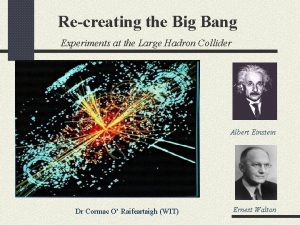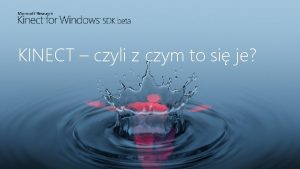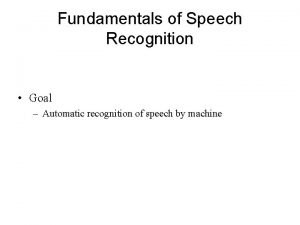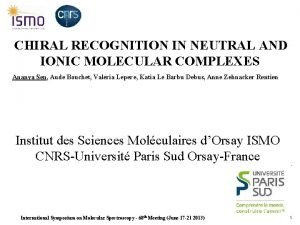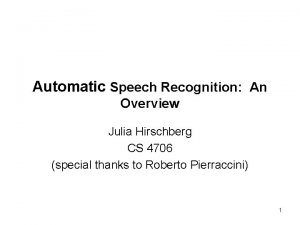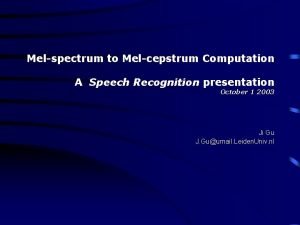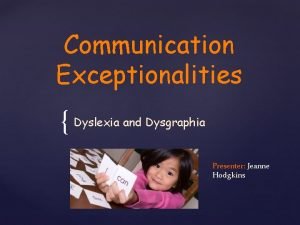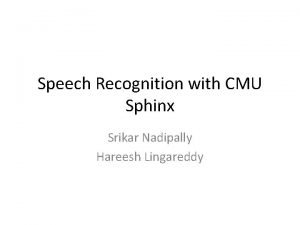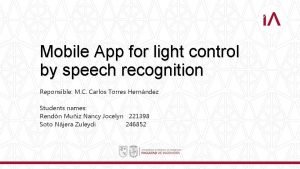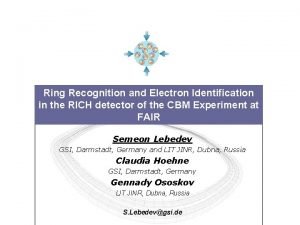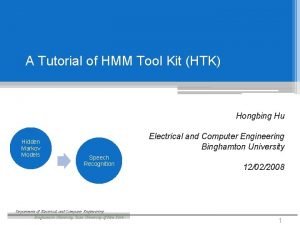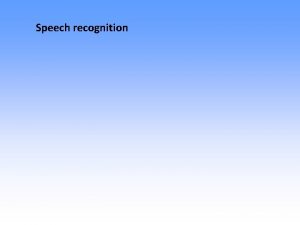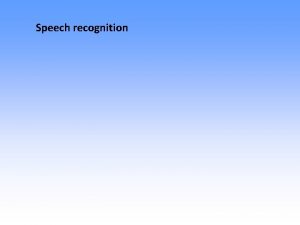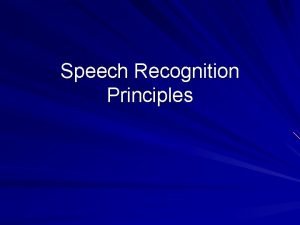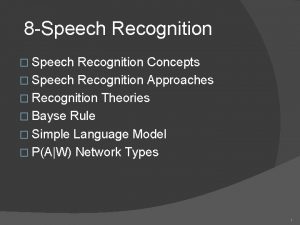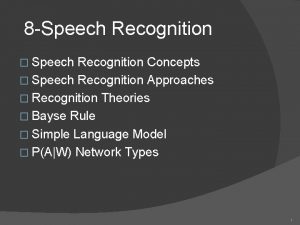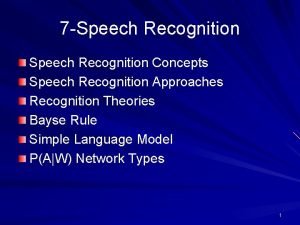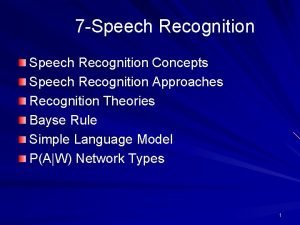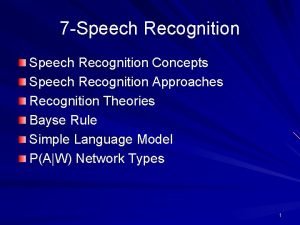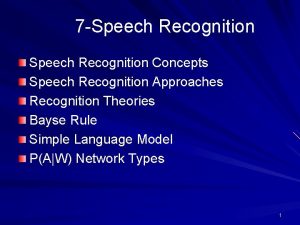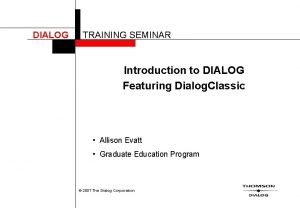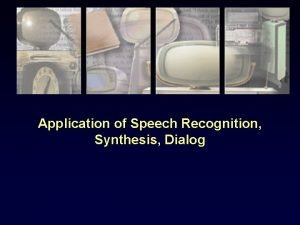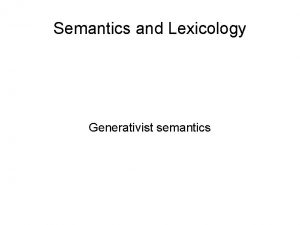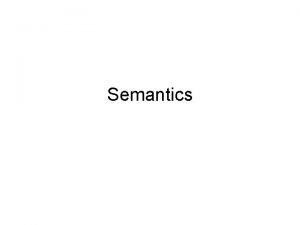Speech recognition DIALOG Recreating the Speech Chain SEMANTICS














































- Slides: 46

Speech recognition


DIALOG Recreating the Speech Chain SEMANTICS SPOKEN LANGUAGE UNDERSTANDING SPEECH RECOGNITION SYNTAX LEXICON MORPHOLOGY SPEECH SYNTHESIS DIALOG MANAGEMENT PHONETICS INNER EAR ACOUSTIC NERVE VOCAL-TRACT ARTICULATORS 3

Speech Recognition: the Early Years • 1952 – Automatic Digit Recognition (AUDREY) – Davis, Biddulph, Balashek (Bell Laboratories) 4

1960’s – Speech Processing and Digital Computers § AD/DA converters and digital computers start appearing in the labs James Flanagan Bell Laboratories 5

The Illusion of Segmentation. . . or. . . Why Speech Recognition is so Difficult (user: Roberto (attribute: telephone-num value: 7360474)) VP NP NP MY IS NUMBER m I n & m &r i b THREE SEVEN ZERO NINE s e v & nth r. E n I n z E o r TWO t ü FOUR s ev& n f O r 6

The Illusion of Segmentation. . . or. . . Ellipses and Anaphors Why Speech Recognition is so Difficult Limited vocabulary Multiple Interpretations Speaker Dependency (user: Roberto (attribute: telephone-num value: 7360474)) Word variations VP NP Word confusability NP MY IS NUMBER THREE SEVEN ZERO NINE Context-dependency SEVEN TWO Coarticulation FOUR Noise/reverberation m I n & m &r i b s e v & nth r. E n I n z E o Intra-speaker t ü s e v &variability f O r n r 7

1969 – Whither Speech Recognition? General purpose speech recognition seems far away. Socialpurpose speech recognition is severely limited. It would seem appropriate for people to ask themselves why they are working in the field and what they can expect to accomplish… It would be too simple to say that work in speech recognition is carried out simply because one can get money for it. That is a necessary but not sufficient condition. We are safe in asserting that speech recognition is attractive to money. The attraction is perhaps similar to the attraction of schemes for turning water into gasoline, extracting gold from the sea, curing cancer, or going to the moon. One doesn’t attract thoughtlessly given dollars by means of schemes for cutting the cost of soap by 10%. To sell suckers, one uses deceit and offers glamour… Most recognizers behave, not like scientists, but like mad inventors or untrustworthy engineers. The typical recognizer gets it into his head that he can solve “the problem. ” The basis for this is either individual inspiration (the “mad inventor” source of knowledge) or acceptance of untested rules, schemes, or information (the untrustworthy engineer approach). The Journal of the Acoustical Society of America, June 1969 J. R. Pierce Executive Director, Bell Laboratories 8

1971 -1976: The ARPA SUR project • Despite anti-speech recognition campaign led by Pierce Commission ARPA launches 5 year Spoken Understanding Research program • Goal: 1000 -word vocabulary, 90% understanding rate, near real time on 100 mips machine • 4 Systems built by the end of the program LESSON LEARNED: – – SDC (24%) Hand-built knowledge does not scale up Need of a global “optimization” criterion BBN’s HWIM (44%) CMU’s Hearsay II (74%) CMU’s HARPY (95% -- but 80 times real time!) • Rule-based systems except for Harpy – Engineering approach: search network of all the possible utterances Raj Reddy -- CMU 9

• Lack of clear evaluation criteria – ARPA felt systems had failed – Project not extended • Speech Understanding: too early for its time • Need a standard evaluation method 10

1970’s – Dynamic Time Warping The Brute Force of the Engineering Approach TEMPLATE (WORD 7) T. K. Vyntsyuk (1968) H. Sakoe, S. Chiba (1970) Isolated Words Speaker Dependent Connected Words Speaker Independent Sub-Word Units UNKNOWN WORD 11

1980 s -- The Statistical Approach • Based on work on Hidden Markov Models done by Leonard Baum at IDA, Princeton in the late 1960 s • Purely statistical approach pursued by Fred Jelinek and Jim Baker, IBM T. J. Watson Research • Foundations of modern speech recognition engines Fred Jelinek Acoustic HMMs a 11 S 1 a 22 a 12 S 2 Word Tri-grams a 33 a 23 S 3 Jim Baker § No Data Like More Data § Whenever I fire a linguist, our system performance improves (1988) § Some of my best friends are linguists (2004) 12

1980 -1990 – Statistical approach becomes ubiquitous • Lawrence Rabiner, A Tutorial on Hidden Markov Models and Selected Applications in Speech Recognition, Proceeding of the IEEE, Vol. 77, No. 2, February 1989. 13

1980 s-1990 s – The Power of Evaluation 1995 1996 1997 1998 1999 2000 2001 2002 2003 2004 HOSTING MIT SPEECHWORKS SPOKEN DIALOG INDUSTRY SRI NUANCE … STANDARDS APPLICATION DEVELOPERS TOOLS Pros and Cons of DARPA programs STANDARDS PLATFORM INTEGRATORS STANDARDS VENDORS + Continuous incremental improvement - Loss of “bio-diversity” TECHNOLOGY 14

Today’s State of the Art • Low noise conditions • Large vocabulary – ~20, 000 -60, 000 words or more… • • Speaker independent (vs. speaker-dependent) Continuous speech (vs isolated-word) Multilingual, conversational World’s best research systems: • Human-human speech: ~13 -20% Word Error Rate (WER) • Human-machine or monologue speech: ~3 -5% WER 15



















http: //www. youtube. com/watch? v=Qil 4 kmvm 2 Sw http: //www. youtube. com/watch? v=o. VYCj. L 54 qo. Y

Figure 1: A typical architecture of the neocognitron • The lowest stage is the input layer consisting of two-dimensional array of cells, which correspond to photoreceptors of the retina. • There are retinotopically ordered connections between cells of adjoining layers. Each cell receives input connections that lead from cells situated in a limited area on the preceding layer. • Layers of "S-cells" and "C-cells" are arranged alternately in the hierarchical network. (In the network shown in Fig. 1, a contrast-extracting layer is inserted between the input layer and the S-cell layer of the first stage).

• S-cells work as feature-extracting cells. They resemble simple cells of the primary visual cortex in their response. Their input connections are variable and are modified through learning. • After having finished learning, each S-cell come to respond selectively to a particular feature presented in its receptive field. • The features extracted by S-cells are determined during the learning process. • Generally speaking, local features, such as edges or lines in particular orientations, are extracted in lower stages. • More global features, such as parts of learning patterns, are extracted in higher stages.

• C-cells, which resembles complex cells in the visual cortex, are inserted in the network to allow for positional errors in the features of the stimulus. • The input connections of C-cells, which come from S-cells of the preceding layer, are fixed and invariable. • Each C-cell receives excitatory input connections from a group of S-cells that extract the same feature, but from slightly different positions. • The C-cell responds if at least one of these S-cells yield an output. Even if the stimulus feature shifts in position and another S-cell comes to respond instead of the first one, the same C-cell keeps responding. • Thus, the C-cell's response is less sensitive to shift in position of the input pattern. • We can also express that C-cells make a blurring operation, because the response of a layer of S-cells is spatially blurred in the response of the succeeding layer of C-cells.

• Each layer of S-cells or C-cells is divided into sub-layers, called "cell-planes", according to the features to which the cells responds. • The cells in each cell-plane arranged in a two-dimensional array. • A cell-plane is a group of cells that are arranged retinotopically and share the same set of input connections. • In other words, the connections to a cell-plane have a translational symmetry. • As a result, all the cells in a cell-plane have receptive fields of an identical characteristic, but the locations of the receptive fields differ from cell to cell.

Figure 4: An example of the response of a neocognitron that has been trained to recognize handwritten digits. The input pattern is recognized correctly as '5'

Figure 2: The process of pattern recognition in the neocognitron. The lower half of the figure is an enlarged illustration of a part of the network • In the whole network, with its alternate layers of S-cells and C-cells, the process of feature-extraction by S-cells and toleration of positional shift by C-cells is repeated. • During this process, local features extracted in lower stages are gradually integrated into more global features, as illustrated in Fig. 2

Figure 3: The principle for recognizing deformed patterns. Since small amounts of positional errors of local features are absorbed by the blurring operation by C-cells, an Scell in a higher stage comes to respond robustly to a specific feature even if the feature is slightly deformed or shifted. • Fig. 3 illustrates this situation. Let an S-cell in an intermediate stage of the network have already been trained to extract a global feature consisting of three local features of a training pattern ‘A’ as illustrated in Fig. 3(a). • The cell tolerates a positional error of each local feature if the deviation falls within the dotted circle. • The S-cell responds to any of the deformed patterns shown in Fig. 3(b). • The toleration of positional errors should not be too large at this stage. If large errors are tolerated at any one step, the network may come to respond erroneously, such as by recognizing a stimulus like Fig. 3(c) as an 'A' pattern. • Thus, tolerating positional error a little at a time at each stage, rather than all in one step, plays an important role in endowing the network with the ability to recognize even distorted patterns.

• The C-cells in the highest stage work as recognition cells, which indicate the result of the pattern recognition. • Each C-cell of the recognition layer at the highest stage integrates all the information of the input pattern, and responds only to one specific pattern. • Since errors in the relative position of local features are tolerated in the process of extracting and integrating features, the same C-cell responds in the recognition layer at the highest stage, even if the input pattern is deformed, changed in size, or shifted in position. • In other words, after having finished learning, the neocognitron can recognize input patterns robustly, with little effect from deformation, change in size, or shift in position.

• The neocognitron can be trained to recognize patterns through learning. • Only S-cells in the network have their input connections modified through learning. • Various training methods, including unsupervised learning and supervised learning, have been proposed so far. • This section introduces a process of unsupervised learning. • In the case of unsupervised learning, the self-organization of the network is performed using two principles. • The first principle is a kind of winner-take-all rule: among the cells situated in a certain small area, which is called a hypercolumn, only the one responding most strongly becomes the winner. • The winner has its input connections strengthened. The amount of strengthening of each input connection to the winner is proportional to the intensity of the response of the cell from which the relevant connection leads.

Figure 5: Connections converging to an S-cell in the learning phase • S-cell receives variable excitatory connections from a group of C-cells of the preceding stage as illustrated in Fig. 5. • Each S-cell is accompanied with an inhibitory cell, called a V-cell. • The S-cell also receives a variable inhibitory connection from the V-cell. • The V-cell receives fixed excitatory connections from the same group of C-cells as does the S-cell, and always responds with the average intensity of the output of the C-cells. • The initial strength of the variable connections is very weak and nearly zero. • Suppose the S-cell responds most strongly among the S-cells in its vicinity when a training stimulus is presented. • According to the winner-take-all rule described above, variable connections leading from activated C-cells are strengthened. • The variable excitatory connections to the S-cell grow into a template that exactly matches the spatial distribution of the response of the cells in the preceding layer. • The inhibitory variable connection from the V-cell is also strengthened at the same time to the average strength of the excitatory connections.

• After the learning, the S-cell acquires the ability to extract a feature of the stimulus presented during the learning period. • Through the excitatory connections, the S-cell receives signals indicating the existence of the relevant feature to be extracted. • If an irrelevant feature is presented, the inhibitory signal from the V-cell becomes stronger than the direct excitatory signals from the C-cells, and the response of the S-cell is suppressed. • Once an S-cell is thus selected and has learned to respond to a feature, the cell usually loses its responsiveness to other features. • When a different feature is presented, a different cell usually yields the maximum output and learns the second feature. Thus, a "division of labor" among the cells occurs automatically. • The second principle for the learning is introduced in order that the connections being strengthened always preserving translational symmetry, or the condition of shared connections. • The maximum-output cell not only grows by itself, but also controls the growth of neighboring cells, working, so to speak, like a seed in crystal growth. • To be more specific, all of the other S-cells in the cell-plane, from which the “seed cell” is selected, follow the seed cell, and have their input connections strengthened by having the same spatial distribution as those of the seed cell.

http: //www. youtube. com/watch? v=Qil 4 kmvm 2 Sw http: //www. youtube. com/watch? v=o. VYCj. L 54 qo. Y
 Recreating the big bang
Recreating the big bang Recreating pangea
Recreating pangea Ragam dialog (dialog style)
Ragam dialog (dialog style) Karakteristik ragam dialog
Karakteristik ragam dialog Compare procedural semantics and declarative semantics.
Compare procedural semantics and declarative semantics. Sequence of food chain
Sequence of food chain Kinect for windows runtime
Kinect for windows runtime Fundamentals of speech recognition
Fundamentals of speech recognition Deep learning speech recognition
Deep learning speech recognition Ionic speech recognition
Ionic speech recognition Julia speech recognition
Julia speech recognition Speech recognition presentation
Speech recognition presentation Speech recognition software
Speech recognition software Cmu speech recognition
Cmu speech recognition Speech recognition
Speech recognition Speech recognition app inventor
Speech recognition app inventor Dragon speech recognition
Dragon speech recognition Electron speech recognition
Electron speech recognition Htk speech recognition tutorial
Htk speech recognition tutorial Value chain and supply chain difference
Value chain and supply chain difference Open kinetic chain
Open kinetic chain Hát kết hợp bộ gõ cơ thể
Hát kết hợp bộ gõ cơ thể Lp html
Lp html Bổ thể
Bổ thể Tỉ lệ cơ thể trẻ em
Tỉ lệ cơ thể trẻ em Gấu đi như thế nào
Gấu đi như thế nào Tư thế worm breton là gì
Tư thế worm breton là gì Chúa yêu trần thế
Chúa yêu trần thế Môn thể thao bắt đầu bằng chữ đua
Môn thể thao bắt đầu bằng chữ đua Thế nào là hệ số cao nhất
Thế nào là hệ số cao nhất Các châu lục và đại dương trên thế giới
Các châu lục và đại dương trên thế giới Công của trọng lực
Công của trọng lực Trời xanh đây là của chúng ta thể thơ
Trời xanh đây là của chúng ta thể thơ Cách giải mật thư tọa độ
Cách giải mật thư tọa độ 101012 bằng
101012 bằng độ dài liên kết
độ dài liên kết Các châu lục và đại dương trên thế giới
Các châu lục và đại dương trên thế giới Thể thơ truyền thống
Thể thơ truyền thống Quá trình desamine hóa có thể tạo ra
Quá trình desamine hóa có thể tạo ra Một số thể thơ truyền thống
Một số thể thơ truyền thống Bàn tay mà dây bẩn
Bàn tay mà dây bẩn Vẽ hình chiếu vuông góc của vật thể sau
Vẽ hình chiếu vuông góc của vật thể sau Biện pháp chống mỏi cơ
Biện pháp chống mỏi cơ đặc điểm cơ thể của người tối cổ
đặc điểm cơ thể của người tối cổ Thế nào là giọng cùng tên?
Thế nào là giọng cùng tên? Vẽ hình chiếu đứng bằng cạnh của vật thể
Vẽ hình chiếu đứng bằng cạnh của vật thể Tia chieu sa te
Tia chieu sa te
